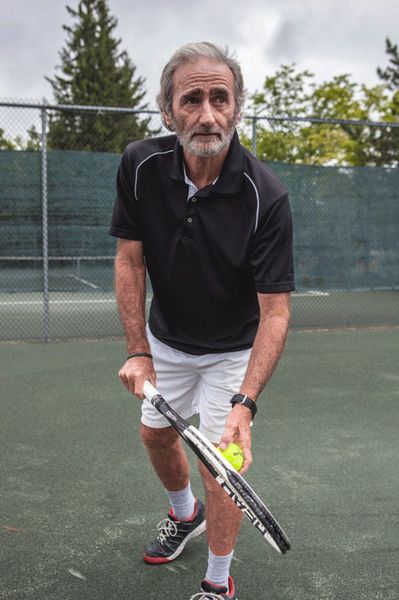TENNIS TIPS: Embracing the spin serve

Photo by Shaun Ondak Jak Beardsworth demonstrates the arm-racket start position to produce a spin serve.
If your arm-racket start position on serve doesn’t look something like the one I’m getting ready to serve with in the photo you’re probably serving a spin-less, flat serve with long-term limitations.
You cannot easily impart serve-enhancing spin with the same grip you’re using on forehand. Yet, that’s precisely the reason why so many players get stuck, too often seldom graduating to “bending” (yes, like Beckham) their serves in, and plateau with their strictly flat deliveries, their Wimbledon dreams permanently dashed.
In the image you can see that I’m not remotely close to a forehand grip position. Since I am about to bend one in – also loosely referred to as a topspin serve – note the backhand grip and the aforementioned arm-racket configuration (a version of which you typically see on TV) with the resulting “closed” racket face. A less exaggerated continental position, with the racket head right on edge, can work just as well.
Keeping in mind that since the service box – only 18 feet long and 13.5 feet wide – accounts for a mere 17 percent of the in-point whole court (doubles), aggressively clearing the net safely without being long is challenging. That’s why you get two.
Plus, never lose sight of the fact that serves in the net have zero chance for success. So when you miss, miss long. It’s okay; that’s a good miss.
So what is the magic elixir of spin on serve? Enhancing gravity.
When the ball is traveling through the air with rapid forward rotation – let’s say 20 rotations per second – the ensuing air pressure on top of the ball becomes greater than the pressure below the ball, making it descend at a faster rate than a ball struck flat.
Up, safely over, and still in.
The resulting looping trajectory, versus the laser beam of flat delivery, allows for a far greater and forgiving margin to the net – a bigger vertical space above the net to pass the ball through while still dropping it in. Because of the accompanying steeper angle of descent, the ball will bounce considerably higher and out of the returners preferred knee-to-thigh-high “wheelhouse” power zone. Advantage you.
Now, how do you hit it? No worries, you already know how.
Initially, now that you’ve altered the face of the racket at impact because of the grip change – at first only an extremely small change from your flat grip (1/16-of-an inch max) is necessary – the ball will not be struck head-on (flat), but instead will be, ideally with unrestrained racket speed, brushed up, over and around the 1 o’clock side of the ball creating an effective combination of both forward and side spin.
You’ll immediately produce a more rainbow like trajectory, including a bit of right-to-left ball movement as well. You’ll most likely have to adjust your previous serve flight plan and visualize a bit higher and more to the right than you’re accustomed to until your brain wires it in.
It’s recommended that you put in some individual practice before unveiling it even in friendly play – using it exclusively in first-serve situations only at first – until you own it and it becomes, ultimately, a reliable solid second-serve “bender.”
Now you really can be like Beckham.
—
Do your best. Always aspire higher. Love the game.
Jak Beardsworth, USPTA Elite Pro, is available for lessons at the Crowne Plaza-Lake Placid Club. JB1tennis@comcast.net, 941-626-0097, www.JakBeardsworthTennis.com.





